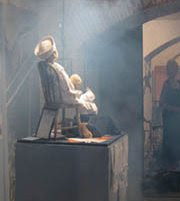Sunday, September 30, 2012
Risking it all at Sea
Cubans have crossed treacherous waters to make the journey to the U.S. since 1959 when Fidel Castro came into power. The limited number of visas does not fulfill the demand for those Cubans wanting to leave their country, so they have resorted to other means.
They have risked their lives on boats of different sizes or homemade vessels called CHUGS that are not always sea-worthy. Cubans are motivated by the “wet-foot, dry foot” policy that allows those who reach dry land in the U.S. to remain in the country. If they are intercepted at sea, the Cubans get deported. However, if they manage to reach American soil they are allowed to stay in the U.S. and are granted Green Cards.
The waters of Florida are constantly patrolled by the Border Patrol and by the U.S. Coast Guard, yet it is estimated that more than 16,000 Cubans make it to the U.S. successfully every year.
http://www.usimmigrationsupport.org/wetfoot-dryfoot.html
Photo by Benjamin Curry Bruce
Thursday, September 20, 2012
First Day of Fall 2012: The Autumnal Equinox
First Day of Fall 2012: The Autumnal Equinox
According to the Almanac the first day of fall for 2012 begins in the Northern Hemisphere on September 22, 10:49 A.M. EDT The word equinox comes from the Latin words for "equal night." The fall and spring equinoxes are the only days of the year in which the Sun crosses the celestial equator.
Fall in Key West is a bit different. It’s all about the subtle changes, in the weather and on the island. A seasoned visitor or residents can recognize a drop in the humidity, a stronger breeze, and notice a calmer Key West atmosphere as the island locals take their final vacations and start their preparations for Fantasy Fest.
According to the Almanac the first day of fall for 2012 begins in the Northern Hemisphere on September 22, 10:49 A.M. EDT The word equinox comes from the Latin words for "equal night." The fall and spring equinoxes are the only days of the year in which the Sun crosses the celestial equator.
Fall in Key West is a bit different. It’s all about the subtle changes, in the weather and on the island. A seasoned visitor or residents can recognize a drop in the humidity, a stronger breeze, and notice a calmer Key West atmosphere as the island locals take their final vacations and start their preparations for Fantasy Fest.
Friday, September 7, 2012
The Perky Bat Tower
The Perky Bat Tower was built in 1929 by Richter Clyde Perky, a fish lodge owner, to control the mosquito problem in the Lower Keys. The tower was built from plans purchased from a Charles Campbell of Texas, an early pioneer of bat studies. The Hygiostatic Bat Roost, as Campbell called it, was intended to be a roost for bats that would eat the mosquitoes which spread illness and disease. A great idea except for one small problem… the bats would not live in their man-made home.
Today the pesky insects are controlled by the Mosquito Patrol board while the Perky Bat Tower stands as another monument to the Florida keys strange and quirky history.
The Sugarloaf Key Bat Tower is an historic site in Monroe County, Florida, United States. It is located a mile northwest of U.S. 1 on Lower Sugarloaf Key at mile marker 17. On May 13, 1982, it was added to the U.S. National Register of Historic Places.
Sunday, September 2, 2012
REMEMBERING THE GREAT LABOR DAY HURRICANE
The Florida Keys Memorial, known locally as the "Hurricane Monument," was built to honor hundreds of American veterans and local citizens who perished in the "Great Hurricane" on Labor Day, September 2, 1935. Islamorada sustained winds of 200 miles per hour (322 kph) and a barometer reading of 26.36 inches (66.95 cm) for many hours on that fateful holiday; most local buildings and the Florida East Coast Railway were destroyed by what remains the most savage hurricane on record. Hundreds of World War I veterans who had been camped in the Matecumbe area while working on the construction of U.S. Highway One for the Works Progress Administration (WPA) were killed. In 1937 the cremated remains of approximately 300 people were placed within the tiled crypt in front of the monument. The monument is composed of native keystone, and its striking frieze depicts coconut palm trees bending before the force of hurricane winds while the waters from an angry sea lap at the bottom of their trunks. Monument construction was funded by the WPA and regional veterans' associations. Over the years the Hurricane Monument has been cared for by local veterans, hurricane survivors, and descendants of the victims.
Subscribe to:
Comments (Atom)












